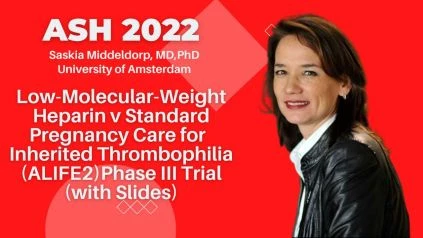Inherited Thrombophilia: Pregnancy & Heparin – Middeldorp, MD- ASH 2022
By Saskia Middeldorp, MD
I’m able to present the results of the ALIFE2 trial for you today. For everyone tomorrow. This trial investigated low molecular weight heparin and standard pregnancy care.
First, a standard pregnancy care alone for women with recurrent miscarriage and inherited forms of Thrombophilia. , we have previously shown that in unexplained recurrent miscarriage antithrombotic therapy with low molecular heparin or aspirin does not help. in women with Thrombophilia in that trial, however, we noticed a relative risk of 31.31, so 30% more chances of having a live birth in the very small subgroup of women with inherited Thrombophilia that were included in that study.
So we then designed ALIFE2 two study, which is a multi-center study with the inclusion criteria listed here. We even had to have had two or more miscarriages confirmed inherited thrombophilia. These are factor five lidin prothrombin mutations. Or a deficiency of antithrombin protein C or protein S, and they had to be randomized and started treatment. Prior to seven weeks of gestational age, we had two coordinating centers in Amsterdam and in Warwick uk.
And we randomized as set towards low molecular heparin, no low molecular heparin. The primary outcome was live. and safety outcomes were obvious for a study in pregnant women with an anticoagulant. After screening more than 10,000 women over a period of nine years, we were able to register more than 400 women and to randomize 326.
And you can see the baseline characteristics here. Approximately 70% of the women had three or more miscarriages, and you can see as expected that the majority had factor five, liden, heterozygous, or Prothro invitation. But we also had women. With the more severe thrombophilias or combined thrombophilias included, I’m now getting to the primary endpoint and of course, we hypothesized that due to blood clotting or other effects of thrombophilia, we would increase the live birth.
That was the hypothesis of the study. , but what we observed was a 71% live birth, as you can see in this graph with an absolute difference of 0.7% and the confidence intervals shown between minus 9% and 10%, meaning that we could not exclude a 10% difference in either direction. The O ratios also adjusted for major variations in baseline characteristics.
Did also not show an increase in life birth rate by the intervention with low molecular heparin. What we did observe, however, was a difference in side effects in adverse offense. I’m showing the overall numbers, the proportion of women who reported one or more side effects or adverse offenses here.
And the differences were explained by minor side effects, but very annoying side effects for women who have to inject themselves for the entire pregnancy. Easy bruising, skin reactions at injection size and minor bleeding. and this difference was statistically significant. So the conclusions and take home messages I think are pretty clear and I’m very pleased that we, in my view at least, have ended a debate of decades.
In pregnant women with inherited thrombophilia and recurrent miscarriage, the live birth rate is approximately 70% with standard pregnancy care. And I think this is also important, we should not say this is a negative study, but what we can do in our offices, in our practices is reassure women with the history of recurrent pregnancy loss, that they have 70% chances of having a healthy baby at the end of the day in their next pregnancy.
Low molecular heparin, however, does not increase this life birth rate, and therefore, following up from this, we should not treat women with low molecular heparin to prevent miscarriage and even more so we shouldn’t test them for inherited thrombophilia for this indication. And therefore the impact I think can be pretty large.
We can avoid low molecular heparin during pregnancy. This will lower the burden of treatment and cost savings. And this is just a rough farrier, rough estimates are approximately three and a half thousand dollars for the US. For the entire pregnancy, but even more so if we avoid thrombophilia testing in this entire group.
For every identified patient, and I think these are conservative estimates, we would save another $4,000. And finally, but not least, I am extremely proud that on behalf of all my co collaborators we can state that thermo prophylaxis, randomized controlled trials in pregnancy can and must be done. And I’m doing this on behalf of the ALIFE2 investigators, but also would like to draw your attention to the high low study that we published earlier.
Thank you for your attention,

